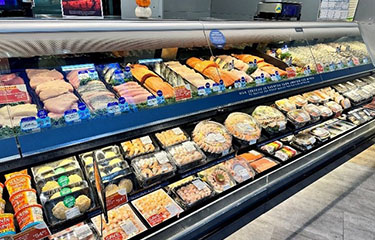US retail seafood outlook more positive for second half of 2023

While 2022 was a challenging year for retail seafood sales due to inflation amongst other problems, retailers and analysts are optimistic for a brighter 2023.
Fresh seafood sales across retail outlets dropped 8.2 percent to USD 6.5 billion (EUR 6 billion) for the year ending 1 January, according to IRI and 210 Analytics. Frozen seafood realized a much smaller decline, falling 2.9 percent to around USD 7.1 billion (EUR 6.6 billion).
Shelf-stable seafood was the star of the year, sporting a sales hike of 5.6 percent to around US 2.67 billion (EUR 2.5 billion).
Overall prices for groceries increased 11.8 percent in December versus December 2021 but only 0.2 percent versus November 2022, according to the U.S. Bureau of Labor Statistics’ most recent Consumer Price Index report.
Seafood prices jumped 5 percent in December compared to the previous December – lower than previous months – and were up only 0.8 percent compared to November 2022.
IRI predicts total food inflation to be lower in 2023 than 2022 and seafood inflation should be lower as well, IRI Executive Vice President, Americas Protein Practice Leader Chris DuBois told SeafoodSource.
“Meat and seafood inflation have been trending lower than total Food and Beverage and IRI expects them to continue lower,” DuBois said.
IRI projects overall food and beverage prices to increase around 7 percent to 9 percent, leading to a 5 percent to 7 percent hike in sales.
Most major retailers are “hurting from overall food price inflation,” Santa Monica Seafood President and CEO Roger O’ Brien told SeafoodSource. “Seafood is only one of numerous higher-priced items for retailers.”
While price inflation has been higher for beef, pork and chicken than seafood, chicken is “still considered a bargain by consumers since a 15 percent increase on a USD 2.00 [EUR 1.85] piece of chicken isn’t the same as a 10 percent increase on a USD 20.00 [EUR 18.54] seafood item,” O’Brien said.
O’Brien said he expects grocery retailers to place a “freeze” or price reduction on numerous items throughout the store and tell suppliers to “figure out how to support this.”
“Retailers have the leverage to do this…[so they] will be passing the buck to their suppliers to lower prices to get consumers back in their stores," O'Brien said. "This is already happening in the U.K., where inflation and food costs are worse than in the U.S."
O’Brien predicts retailers will continue to suffer during the first half of 2023, “especially when the media goes crazy scaring consumers once a formal recession is announced,” he said.
Wells Fargo Senior Economist Tim Quinlan said on 18 January at the 2023 National Fisheries Institute Global Seafood Market Conference in La Quinta, California, U.S.A., that his bank has already "penciled in" a recession this year.
On the other hand, O'Brien said he expects the third and fourth quarter of 2023 to show improvements for retailers in customer counts, sales, and profits.
DuBois feels “very optimistic” about seafood volume this year because transport costs have declined and “harvests are strong in key categories which should leave plenty of supply.”
“Wild-caught salmon, lobster, and other items will likely play a bigger role in 2023 and we’re seeing stronger volumes in many categories where pricing has come down in the last 12 weeks,” DuBois said.
2023 should be a “modestly good year” for seafood sales, DuBois said, as he expects some retailers to add back assortment – particularly in the fresh cases. Overall, seafood should stabilize “as long as any recession is relatively mild.”
Kroger CEO Rodney McMullen told Supermarket News his company expects grocery price inflation to remain relatively high early in the year, but to ease later in the year.
“There are some CPG [companies] that continue to pass cost increases through,” McMullen said.
Conagra, which controls the frozen seafood brands Van de Kamp’s and Mrs. Paul’s, will not have “any more significant price increases unless our cost, our inflation estimate, starts to go back up,” Conagra Chief Financial Officer David Marberger told the The Wall Street Journal. In July 2021, Conagra Brands President and CEO Sean Connelly said in a press release the company needed to raise prices because fiscal 2022 input cost inflation was “materially higher than we anticipated at the end of fiscal Q3.”
Photo courtesy of Gelson’s





Share